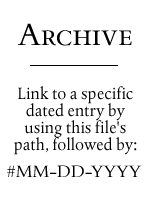|
|
|

|
 April
29, 2008: Between Fire and Ice April
29, 2008: Between Fire and Ice
Sure, maybe
the guy's a nut, but I'm a contrarian and I love heresies. There
certainly seem to be fewer sunspots this cycle than we're used to,
and cooling climate trends are definitely correlated with things
like the Dalton
Minimum and the Maunder
Minimum. I've sometimes wonder if the Little
Ice Age was "little" because we aborted it by throwing
CO2 into the atmosphere in serious quantities. Absent that, we might
all be cavemen in an ice wilderness by now.
Ahh. Maybe the Earth really has a little old lady named Gaia somewhere
pulling strings. Maybe prescient whales (or sentient mushroom rings
in the English forests) saw it coming and carefully guided the evolution
of humanity so that it would control fire. Fire is addictive. Do
enough of it, and you can keep the atmosphere warm through the greenhouse
effect. Maybe the Earth got tired of being cold, and it evolved
us because it didn't have any leg warmers.
Climate is an interesting business. The Earth seems to teeter between
fire and ice, but from what we know of our geophysical history it
prefers ice. If the sunspot dearth is a leading indicator of reduced
solar activity, we may have a few years to do...what? Buy Hummers?
Whoops. We already tried that.
Ok, ok, correlation is not causation. I'll shut up. Still... At
least in Colorado Springs, this was The Winter That Wouldn't End.
And it snowed in Chicago last night. If this keeps up I'm moving
back to Arizona, thank you very much. I hear that when the ice sheets
get as far south as Nebraska, the mammoth hunting is better there.

|
 April
28, 2008: Clay Shirky's Cognitive Surplus April
28, 2008: Clay Shirky's Cognitive Surplus
Minnehaha sent
me a pointer to an article by Clay
Shirky about the
"cognitive surplus"—excess brainpower not needed
for making a living. Thought-provoking in the extreme; read
it if you haven't already. Shirky's thesis is that free time created
by postwar productivity gains have been sopped up by watching TV,
and if we watched only a little less TV and deployed that wasted
brain-time in collaborative projects, wow! The things we could do!
I'm short on time today, so I'll post a few quick observations on
the article and the idea here, in the hope for more general conversation:
- The consequences of the invention of gin are very well covered
by Colin Wilson in his book A Criminal History of Mankind.
The problem was not solved for 200 years—the urban poor drinking
themselves to death was the primary reason for Prohibition—and
it's still not entirely clear to me how it was solved. My guess:
Universal education and technology (think TV) allowed the poor
to entertain themselves in less destructive was.
- Do we really watch two billion hours of TV every year, or are
TVs simply on for two billion hours? In many households,
TVs provide a sort of background noise to prevent too much disturbing
silence, but how much attention is paid to the box is a lot more
difficult to measure, and I suspect Big Media would prefer that
no one try.
- TV is often watched for the many but very small time slices
that it takes to catch the news or weather. Carol and I watch
very little TV but The Weather Channel, and we watch it in small
chunks of a few minutes a few times a day. It adds up, but converting
those dispersed minutes into productive brain-time may not be
possible. The problem here is not a shortage of time but a shortage
of focus, which is a separate and worthy discussion.
- Almost incredibly, Shirky does not say much about the immense
cognitive energy already spent on collaborative noncommercial
cognitive projects. Think Linux and all open-source software,
tens of thousands of free ebooks scanned and formatted from out-of-copyright
sources (and a few in-copyright sources, like some of mine, sigh)
not to mention the work of all those Pixel-Stained Technopeasants
who had their day (April 23) last week. This is not new news,
though it's good for it to be pointed out now and then.
- Nor is much said about the general rise in volunteering in more
traditional social service pursuits, which by and large are not
cognitive in nature. As problematic as I consider some of his
conclusions, much good data on volunteering is cited in Arthur
Brooks' Who Really Cares? Not all time and energy released
from TV watching now goes into, or would go into, cognitive pursuits.
- And the ugly truth that no one seems willing to recognize: A
huge percentage of people simply don't have the ability
to contribute meaningfully to cognitive projects. This may be
by genetics or by adverse circumstances, but it's true nonetheless.
I keep thinking that a lot of them, if there were no TV, would
go back to gin or to worse things that didn't exist when gin was
invented in 1740.
My early conclusion: There's less cognitive surplus than the article
suggests, and less upside to be gained by turning away from TV.
People inclined to be creative already cluster toward the bottom
of the TV time curve, and a lot of the people I consider brilliant
don't watch TV at all. There is almost certainly an irreducable
minimum number of people who need TV as an anaesthetic, and this
number may be higher than we care to admit. Loneliness, clinical
depression, and other psychiatric problems dissipate and render
useless an immense amount of human energy, and we don't seem any
closer to solving those problems than we were in 1740. Those problems
may not in fact be solvable, though saying so won't make me any
friends.
Still, anything that nudges people away from the box toward creative
or collaborative pursuits of any nature is a good thing. My problem
at this point in my life is not TV but sleep, since I need ten hours
in bed to yield eight hours of useful sleep cycles. The time I used
to spend commuting I now spend wondering why I'm not asleep, and
if I could lick that problem I would get a great deal more done.

|
 April
27, 2008: Odd Lots April
27, 2008: Odd Lots
- We had rockfish for dinner the other night, and since I didn't
know exactly what I was eating, I researched it (it's nothing
remarkable; a sort of domesticated sea bass) but in the process
I happened upon a brilliant little animated hard SF short about
an unflappable interstellar sportsman of the future who goes out
with his faithful pet monkeydog and trolls for The Big Catch:
"Rockfish."
- While we're doing animated videos, don't miss the charmingly
inane steampunk short "A
Gentleman's Duel" from the same studio.
- From Frank Glover comes a pointer to an
interesting article about whether there are "habitable zones"
in our galaxy. We're caught between our schedule, our metals
concentration, and our supernovas, and ferdang, somehow we got
placed "just right." I'm always a little suspicious
of charts that somehow get us dead-center. Supernovas may trigger
lots of interesting things, from radiation-proofed cellular reproduction
systems to "novel" stars and planets. I'm far from sure
that zones closer to the Core are so deadly as to preclude the
evolution of any kind of life—just Life As We Know It.
- Are you nervous about European-style national health care? You
should be.
- Also from the NYT: The
housing crash will likely cut the US birth rate, which roughly
tracks housing availability and may be the reason that the birth
rate is so low in Europe, with its staggering high housing costs.
- A compendium of
really weird products, including wedgie-proof underwear and
a Hilary Clinton toilet bowl brush. What boggles the mind is that
this is not a collection of hoaxes: All of these items are
real.
- Here's an
eye-crossing but interesting paper that explains a lot of
why I dislike competitive sports.
- From David Stafford comes news of one
of the most bizarre motorcycles ever imagined. It's electric.
It works a little like the Segway. It gets points for design,
fersure, but...you ride. I'll watch.

|
 April
22, 2008: Nothing Is Sewn Up Yet April
22, 2008: Nothing Is Sewn Up Yet
By the grace of the Pennsylvania Democratic primary, tonight we
may know who will face off against John McCain this fall. Many were
saying that by tonight we may know who our next President will be,
but even though Big Media long ago declared Obama the King of the
Universe, our Great Pretender has been caught saying the same stupid
condescending things about rural whites that the educated white
elite used to say about urban blacks. Hilary's gotten herself caught
in a few gaffes herself, but she's not the naïf that Obama is and
has kept herself closer to the center. It's still a tossup between
them. Tonight may nail it, but it may not.
I don't do politics here very often, so I'll offer a few notes
on the race so far and be done for another month or two:
- There are clearly no such things as "private remarks" or "this
is off the record" anymore. We've taught our young people for
years that politics has no rules, that outright hatred of whole
groups for political reasons is completely acceptable under the
banner of the First Amendment and "political speech,"
and that it doesn't matter how you do it as long as you win. Those
striving for elected office these days have to be very
careful what they say and where they say it, because the blogosphere
is full of people who will gleefully publish it and by doing so
make it eternal. The Internet never forgets. Better to just shut
up and quietly stand on your record, if you have one.
- Something I've noticed in talking with political independents
for many years is that independents don't believe campaign promises.
They understand completely that lying is legal, and that the only
way to judge a candidate is to look at his or her record in detail
(including—or especially—where their money is coming
from) and then extrapolate linearly into the future. When you
give stirring campaign speeches full of promises, you are reassuring
your base, not persuading the center to move in your direction.
Independents call BS on anything candidates say since they first
declared themselves.
- There is a difference between what people say to friends (and
to pollsters) and what they do in the privacy of the voting booth.
It's something like caucusing in the months leading up to the
election: People will say the things that they think they are
expected to say (like "I'm voting for Obama!") to avoid unpleasantness
and conflict within their inner circles. This is a survival tactic
if you live among political tribalists from either side of the
spectrum. On election day, the magic of the secret ballot makes
it possible for "survival centrists" to vote their true hearts,
knowing that no one will catch them out in any lies made earlier
to keep their scalps intact.
- The American electorate is still very closely divided, and
it doesn't take a lot of votes to tip an election. Nobody has
anything sewn up.
Some final speculation pertinent to this last point: Many across
the political spectrum have already written off John McCain, but
that's a mistake. McCain is not seen as a "real" Republican in some
quarters on the right, but Republicans are better nose-holders than
Democrats, and come November McCain will get their votes irrespective
of the Democratic nominee. McCain has cleverly kept his VP spot
open (and generally kept a low profile) and probably will until
he is absolutely sure what he's up against. Having played the race
and gender cards intensely for a couple of years now, the Democrats
have legitimized this kind of tokenism in the public eye. McCain
could easily win against Obama by partnering with either a black
or a Hispanic. He could win against Hilary by partnering with a
woman of any color. In either case, it doesn't matter who.
It's sad that it's come to this, but that's how American politics
is now played, and both political parties had better be ready to
reap the whirlwind in unexpected ways.

|
 April
21, 2008: We Caught Bigfoot! April
21, 2008: We Caught Bigfoot!

Yes, Carol and I caught a Bigfoot a couple of weeks
ago. Big, yes: 25 feet long, and just under 12 feet high. Feet,
no: Our bigfoot has wheels. What we caught was a never-used 2006
Bigfoot Model 30MH24DB RV, and the capture was a bit of an accident.
The local Bigfoot dealer here in Colorado Springs went bankrupt,
and we heard that their inventory was being liquidated. So although
it wasn't precisely what we were looking for, the price asked was
so stunningly good that we decided to give it a shot.
Carol and I have rented RVs before, and I've described
our adventures in this space. We haven't been able to travel as
much as we would like, especially here in the West. Our experience
staying in hotels in out-of-the-way locations has been very mixed
(you can't always find a Hyatt when you want one) and this is one
solution.
We bought it about a month ago, but that was serendipity,
and we didn't have a chance to actually take it out on the road
until this weekend, when we went out with our church's RV group.
The destination was Mountaindale
Campground, which is only 16 miles from our front door, south
down Highway 115 toward Cañon City. We think traveling with
more experienced RVers is a good idea until we get our RV chops,
and that has worked out very well, especially considering that two
of the people in our group are RV repair technicians, one of whom
actually worked for some time at the Bigfoot dealership that went
under.
The Bigfoot is a little taller than a lot of Class
C RVs (Class Cs are the ones with van-ish cabs and a bulge over
the cab) and what that buys is storage space. Beneath the floor
are several compartments that can hold a lot of stuff, one of them
big enough to lug a considerable telescope. Being from Canada, the
unit is much more heavily insulated than RVs built here, not that
I intend to do a lot of cold-weather camping. Insulation works both
ways, and we have hopes that it will take less A/C to keep it cool
in summer.
The weather for our first outing was stunningly good.
Most of what I did was learn how to operate and maintain the unit,
which has a manual so thin and poorly done that it may well be worse
than blissful ignorance. (I had to slap myself to keep from outlining
Bigfoot RVs for Beginners in my head as I was struggling
to make sense of the electrical system.) Carol and I did take QBit
and Aero for a hike up to the top of a nearby hill, but most of
the time we spent taking it easy in the company of friends, and
listening attentively to RV war stories. I may well write my own
damned manual just to keep all the heuristics straight, and if it
gets good enough to go up on Lulu, so much the better. In the meantime,
we have a vehicle in which to see some of Colorado, and attend local
dog shows where Carol will be showing Aero. (There is a lot
of RV culture in the dog show world—and in fact at the recent
Tarry All show north of Denver we ran into a couple who travel in
a Bigfoot unit identical to ours while showing Gordon Setters.)
I'm not sure I could live it for weeks and weeks,
but it will get us around to the mountains I've never seen and don't
want to miss in this life. As for computing in an RV, more on that
as time allows. I learned a lot this weekend, and am learning even
more reading the RV forums online. One addditional thing I learned
is this: Don't use Vista. Really don't use Vista. Every time
I have to rescue somebody from its clutches—as I did this weekend—I
hate it more. Ubuntu 8.04 comes out in three days, and there's a
partition waiting for it, on an SX270 machine that I may "build
in" to the Bigfoot. Again, more on that has it happens.

|
 April
16, 2008: Odd Lots April
16, 2008: Odd Lots
- Ok. It's April 16, and outside it's 30° and blizzarding.
There's about two inches on the ground already and we may get
another 4" - 6" tonight. Would you fools please stop
calling it "global warming" and start calling it "climate
change" before the whole world decides we're idiots?
- In one respect the snow is welcome: There
were two very bad wildfires here in the last couple of days,
one of them only about fifteen miles due south of me, and the
smoke was bad enough to make my allergies go ballistic this morning.
- Interestingly, the fire broke out about a quarter of a mile
from where we intend to go RV camping the day after tomorrow.
(As best we know, the
campground has not seen any fire or other damage on their
land.) Snow
seems to follow us on camping trips. (That little adventure
was on the last day of summer, people!) We're hoping this
time will be different.
- Democrats
in Congress are spearheading an effort to compel states to collect
state taxes on out-of-state online vendors. Far from targeting
corporate fat cats, the effort will cost ordinary people, including
some fairly poor ones, a great deal of money. Tell me, now: How
is this supposed to help you win elections?
- I just bought an off-lease, nearly flawless Dell Optiplex SX270
3.2 GHz Pentium 4 with a 60 GB hard drive and a DVD-ROM...for
$199. Computers, like books, have gotten so cheap that they're
basically disposable. If this machine dies any time soon, I'll
just buy another, wincing a little to imagine that my 1978
Intersystems DPS-1 S-100 bus machine with a 1 MHz 8080 CPU
cost me $3600 1978 dollars. (It was the first and still the coolest-looking
computer I have ever owned that I did not build myself.)
- The story I could not identify in my
April 10, 2008 Odd Lots (about a guy who extracted gold from
seawater) was "The Man Who Ploughed the Sea" by Arthur
C. Clarke, and it was a Harry Purvis story from Tales from
the White Hart.
- From Bruce Schneier's CryptoGram comes a pointer to a
wonderful little piece on what sorts of books bookstore shiplifters
lift, and what sort of man a bookstore shiplifter is. (You do
subscribe to
CryptoGram, don't you?)
- The lyrics to one of the funniest pop songs ever to hit the
Billboard Top 20 is (legally) online, at the author's Web site:
Dean Friedman's
1976 "Ariel."
It's one of the few songs I would ever consent to perform in public,
though that would require that I learn to play some kind of an
instrument. Maybe this.
- Bob Thompson sent me a
link to one of his posts relating (as my entry for yesterday
did) to catalogs of the 1960s, in this case the Sears Catalog.
His comments pertaining to chemistry sets are bang-on, though
I would add that a significant amount of the value of chemistry
sets lay in allowing kids to imagine themselves as scientists—chemistry
has more identifiably iconic paraphernalia than almost any other
scientific discipline—and what kids can't imagine themselves
as, they generally won't become.

|
 April
14, 2008: My Favorite (Or Maybe Second Favorite) Year April
14, 2008: My Favorite (Or Maybe Second Favorite) Year
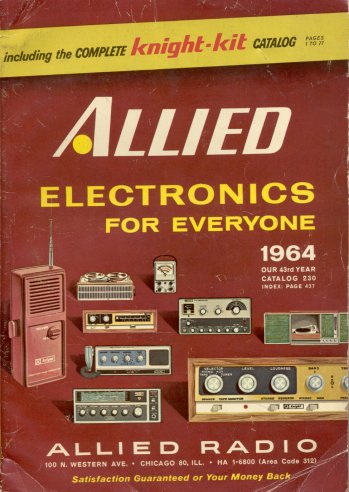 Harry
Helms recently sent me something he thought I might enjoy: A copy
of the 1964 Allied Radio catalog. When I opened the package and
sat down with it, I realized that 1964 might well be my favorite
year, if second to any then second only to the magical summer of
1969, when I met Carol. (1969 was painful at times for reasons that
had nothing to do with Carol, first of which being that in 1964
my father was not dying of cancer.) I turned 12 in the summer of
1964, and had not yet begun to feel the hormone storm that would
close in by the summer of '65 and make me crazy for years to come.
Granted, many of the girls returned to IC School that September
with a couple of things they didn't have the previous June, but
apart from a passing fascination with a little girl named Laura
that fall (which she never found out about—whew!) the whole
girl thing blew past me. Halloween was on a Saturday that year—what
luck!—and it was warm. Ten full hours to scavenge sugar
from the neighbors, and we didn't need three sweaters under our
costumes! Harry
Helms recently sent me something he thought I might enjoy: A copy
of the 1964 Allied Radio catalog. When I opened the package and
sat down with it, I realized that 1964 might well be my favorite
year, if second to any then second only to the magical summer of
1969, when I met Carol. (1969 was painful at times for reasons that
had nothing to do with Carol, first of which being that in 1964
my father was not dying of cancer.) I turned 12 in the summer of
1964, and had not yet begun to feel the hormone storm that would
close in by the summer of '65 and make me crazy for years to come.
Granted, many of the girls returned to IC School that September
with a couple of things they didn't have the previous June, but
apart from a passing fascination with a little girl named Laura
that fall (which she never found out about—whew!) the whole
girl thing blew past me. Halloween was on a Saturday that year—what
luck!—and it was warm. Ten full hours to scavenge sugar
from the neighbors, and we didn't need three sweaters under our
costumes!
But for me in 1964, electronics was the thing. I had discovered
electronics when I was 10, began seriously reading library books
about it and building things when I was 11, and had begun to achieve
some modest success by the time I turned 12. Simple radios were
problematic, because my antenna looked right down the throat of
hillbilly rock station WJJD's 50,000 watt directive array a mile
or so northwest of me in Park Ridge, so I built other things: A
two-transistor organ (with keys made of strips of tin can metal)
a cigar-box intercom (put to good use by the Fox Patrol at Camp
Owassipe that summer) and a capacity-operated proximity relay,
which (being "spooky action at a distance") was about
as close to magic as it came.
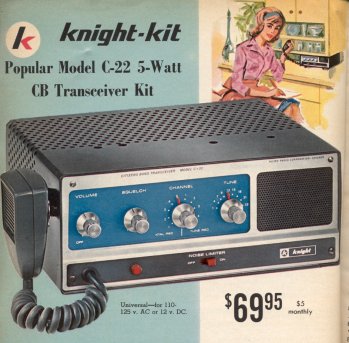 That
summer my father taught me how to take the CTA bus down to Six
Corners (over my mother's strident objection) and always gave
me a couple of dollars to spend at Olson Electronics on Milwaukee
Avenue, back at a time when a couple of dollars would buy a pocketful
of resistors, capacitors, and transistors. Allied was also in town
(at 100 N. Western Avenue) but that was a lot farther away, and
not in an especially good neighborhood. I knew Allied from its catalog
and its catalog alone. That
summer my father taught me how to take the CTA bus down to Six
Corners (over my mother's strident objection) and always gave
me a couple of dollars to spend at Olson Electronics on Milwaukee
Avenue, back at a time when a couple of dollars would buy a pocketful
of resistors, capacitors, and transistors. Allied was also in town
(at 100 N. Western Avenue) but that was a lot farther away, and
not in an especially good neighborhood. I knew Allied from its catalog
and its catalog alone.
But what a catalog! Anything a boy teetering on the edge of the
Age of Lust might want was right there: Ham radio, CB, shortwave,
hi-fi stereo, tape decks, portable radios, test equipment, speakers,
tools, parts cabinets, resistors, capacitors, transformers, Miniboxes,
plugs and sockets and chassis punches and antenna insulators, everything.
The first 77 pages of the catalog was the full list of Knight Kits,
which were cheaper than finished gear because you put them together
yourself. I later went on to build a few a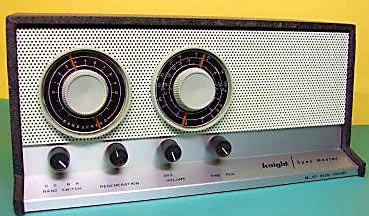 nd
own many more Knight items, including the wonderful T-60 CW/AM transmitter,
the nice LC-1 CPO, the so-so R-55A receiver, and the totally wretched
T150A VFO transmitter, which wandered across more territory and
with more brute persistence than an alley cat. Interestingly, the
Knight Kit I wanted the most in 1964 I never got: The Span Master
shortwave radio (at left) which I thought then (and may still) to
be the coolest-looking radio in history. nd
own many more Knight items, including the wonderful T-60 CW/AM transmitter,
the nice LC-1 CPO, the so-so R-55A receiver, and the totally wretched
T150A VFO transmitter, which wandered across more territory and
with more brute persistence than an alley cat. Interestingly, the
Knight Kit I wanted the most in 1964 I never got: The Span Master
shortwave radio (at left) which I thought then (and may still) to
be the coolest-looking radio in history.
 The
back of the catalog was fascinating, as it listed in minuscule type
endless small electronic parts and hardware, some of which I ordered
through the mail, careful to send enough money to cover the goods
and postage, and often (to be sure I hadn't messed up the shipping
calculations) a little more—which Allied always honestly refunded,
in the form of 4c and 7c credit slips to be applied to my next order.
That part of the catalog is still useful as a reference: If you
run across a Knight 61G466 power transformer at a hamfest, the catalog
will tell you what the output voltages of its various windings are. The
back of the catalog was fascinating, as it listed in minuscule type
endless small electronic parts and hardware, some of which I ordered
through the mail, careful to send enough money to cover the goods
and postage, and often (to be sure I hadn't messed up the shipping
calculations) a little more—which Allied always honestly refunded,
in the form of 4c and 7c credit slips to be applied to my next order.
That part of the catalog is still useful as a reference: If you
run across a Knight 61G466 power transformer at a hamfest, the catalog
will tell you what the output voltages of its various windings are.
Some of the stuff I didn't want, and often had no clear concept
of why it was useful: What good, after all, was a clock radio? I
have an inner alarm clock that I can "set" to any arbitrary
time and have never had any trouble bouncing out of bed at 6 ayem,
often singing. (Carol is a very patient woman.) "You can wake
up to music!" said the ad. Indeed. And you could plug your
coffee pot into the back of the radio, which I just couldn't figure,
as we were a gas household and an electric coffee pot was heresy,
pure and simple. Tachometers and electronic ignition systems—no
visceral response; when you're 12 and "small for your age"
driving is almost unimaginable. The Blonder-Tongue (now there's
a name for you!) TV mast signal amplifiers puzzled me; in Chicago
you could practically get Channel 9 on your fillings. (You would,
if WJJD hadn't already saturated them.)
1964 was the last great year of tube electronics, and the transmitters,
receivers, and test gear units were not only big enough to see,
they were big enough to cause serious injury if dropped on body
parts. (I dropped a Central Electronics 100V transmitter on my thumb
in 1998, and my thumbnail has never been the same since. And hey,
in 1998 I was 46 and careful.) The prices on much of it were
daunting: The Hallicrafters SR-150 SSB transmitter was $689—what
the Inflation Calculator
tells me would cost over $4600 today. The best a 12-year-old boy
could do was look at the pictures and think, Hey, someday I may
have this thing! The Allied catalog was the drool book of all
drool books.
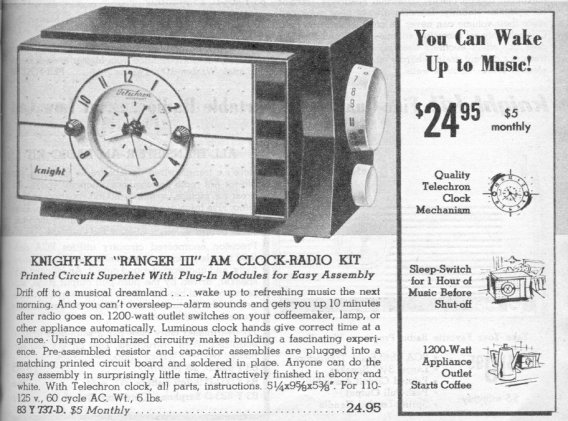
Yes, it was a great year. When my family went out to California
on the Union Pacific that summer, my Allied catalog went with me
(along with several issues of Popular Electronics and a couple
of Alfred Morgan's books) and I got past the endless wheat fields
of eastern Wyoming doodling chassis layouts on a pad of paper. That
fall I built a
regenerative receiver from a Popular Electronics article,
with $15 worth of parts carefully ordered (and paid for by my saintly
father) from the 1965 Allied catalog, which arrived without being
summoned in October. I could never make it work well (though it
picked up WJJD without any trouble) and there were times when I
was tempted to give up electronics and just stare at Laura in English
class like all the other guys did. But no: Girls were mysterious,
and I would be years'n'years figuring them out. (I may still have
a few years to go on that score.) But electronics? You flip a switch,
and things happen. That was my kind of magic, and the Allied
catalog was where it all came from, whether in grand dreams or grubby
reality. I had both, and Halloween was on a Saturday! Life was good.

|
 April
10, 2008: Odd Lots April
10, 2008: Odd Lots
- Those who marveled at the quirky motion of the
Big Dog quadripedal robot should not miss the
(inevitable) video parody.
- And while we're watching videos, make
sure you watch this one, starring a Pope Benedict XVI bobblehead
identical to the one on my bookshelf. While this is what I call
"gentle humor" and I suspect that Good Pope Bennie (with
whom I disagree but whom I do not despise) would have laughed
had he seen it, the usual grump-ass moroons who object to things
like this prevailed to have the ad pulled. Fu on 'em.
- Which of course reminded me of this
famous Far Side cartoon, which incensed Jane Goodall's staffers
but made the great lady herself laugh. My father told me early
on: Life demands a sense of humor. Only cowards cannot laugh at
themselves, and only hopeless slave-collar tribalists cannot abide
humor about their own leaders.
- George Hodous sent me a link to an artist who uses intersecting
lasers to etch a
crystal cube containing a 3-D starmap of our stellar neighborhood
out to five parsecs. Nice work, and if you ever forget, he's marked
the direction to the galactic core.
- Maybe this
is why I started to get muscular in middle age. Thanks to
Frank Glover for the pointer.
- Takahiro Kato of Japan sent me a
link to his page on 12V tube work, including a 30mw transmitter
he designed. It's in Japanese, and (alas) the machine translation
link does about as well as machine translation links generally
do. But look at his construction techniques—I haven't seen
anything that clean and rational for a long time.
- Those who love The Rocketeer (whether the graphic novel
or the film) will want to take a look at this,
documenting a Swedish inventor who has come damned close to making
it real. (Yes, he does look more like Buzz Lightyear than Cliff
Secord.) No explanation here of why his pants don't catch fire,
but hey, wow.
- While hunting for a new standard model thumbdrive to replace
the no-longer-made Cruzer Mini I ran across this
prototype. Not what I need but very cool nonetheless. Let's
just hope they don't pollute it with U3.
- In thinking about non-obvious disruptive technologies, it occurred
to me that using nanotech filters to separate gold from seawater
could be hugely disruptive to nationalk economies if it became
effective. However,
with gold at about thirteen ppt (parts per trillion) in seawater,
it would take a lot of nanofilm to get any useful quantity.
I vaguely recall an old SF story about a guy who pulled gold out
of seawater somehow. Anybody remember what that was?

|
 April
7, 2008: Slide Charts Are Still With Us April
7, 2008: Slide Charts Are Still With Us
Reader Kevin Anetsberger is a fan of nomography
(basically, the use of printed charts as calculating aids) and he
wrote to say that the sorts of "slide charts" I mentioned
in my April 5, 2008 entry are far from extinct—and interestingly
enough, the world center of manufacturing for slide charts is back
in my home town, Chicago. Kevin mentions three companies, and their
Web sites are worth a quick look: Perrygraf,
Datalizer, IWA,
and American Slide
Chart.
And although this was posted in the comments on my LiveJournal
mirror, it's worth reposting for everyone else: A
monograph on nomographs, courtesy Bill Leininger.
I spent a little time looking for instructions on my father's circular
slide rule, and by now I'm pretty sure that the device is a Dietzgen/Gilson
Midget Circular Slide Rule. I found what
may be a manual for it, but it consists of bad TIF scans of
the pages, and it is not easy to read—and the rule itself is
so worn that making out the scales in some cases is impossible.
It was evidently made by Gilson but private labeled and sold by
Dietzgen to fill out their product line. The operation is something
I would not have guessed: You position the two sliders separately
to appropriate scales, and then slide the two as a unit to
a third point to read out the answer. The friction clutch is made
such that sliding the short pointer moves only the short pointer,
but sliding the long pointer moves them both. (I had not noticed
this while fooling around with it.) So you set the long pointer
first, then the short pointer (which does not disturb the position
of the long pointer) and then move the short pointer by moving the
long pointer, at which time the long pointer reads out the answer.
Whew.
Interestingly, about 120° of the front face is much
more worn than the rest of it, suggesting that my father did a lot
of calculating within a relatively narrow range of values. What
he used it for is only one of a multitude of things I would ask
him, if only I had the chance. What he probably would have said
(over a grin) is, "I made things not blow up," which when
your stock in trade is bulk methane would be a very good
thing.
If circular slide rules interest you, this
page presents a number of different models, none of which precisely
match the specimen that I have. And if you want to make your own
circular slide rule, here's a
page with a full how-to. And here's another
site that explains how to make both circular and linear slide
rules.

|
 April
5, 2008: Application-Specific Slide Rules April
5, 2008: Application-Specific Slide Rules
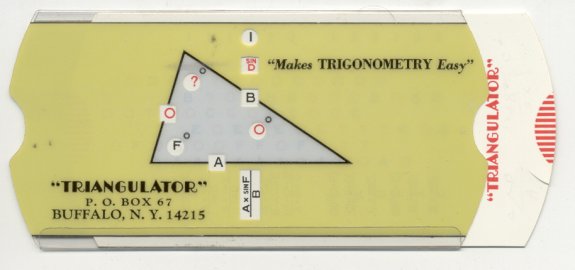
I went in for my upper set work yesterday, and spent eight and
a half hours in the chair, from 7 AM to 3:30 PM. It took two solid
hours for the surgeon to cut my upper horseshoe out of my mouth,
consuming (I asked) twelve burrs in the process, three diamond and
eight carbide. The cottage cheese I had for supper last night tasted
distinctly of machine shop.
But let all that pass; the less you know the better you'll sleep.
What I want to talk about this morning is the fact that slide rules
are not dead. By no means; I use them regularly, if not every single
day. The catch is that they're not general-purpose mathematical
slide rules. They're application-specific slide rules that do one
thing only—or perhaps two or three related things.
A good example is something I got from Carol's late father: The
Triangulator, shown above. It doesn't do trig calculations, but
it sets them up for you, depending on which values for a given triangle
are known, and which are unknown. Slip the slide back and forth
until the holes show you the unknown (a question mark) and the knowns
(printed in black) and it will display the formula you need to run
to get the unknown.
I've used the Triangulator a time or two, but the one that I've
used the most is shown below: Allied Radio's coil winding calculator.
The copyright notice says 1960, and I bought it at a hamfest for
a dollar years'n'years ago. You can use it to quickly figure a coil
for a radio project, assuming you know the inductance required,
and if you don't, the flipside of the calculator calculates resonance
and both inductive and capacitive reactance. (Slide rules, like
records of old, generally had two sides.)
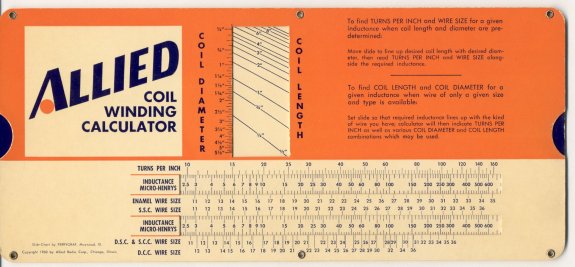
I have a similar reactance calculator from Shure Brothers, but
it doesn't have the coil winding feature. Elsewhere in the collection
are a couple of English/Metric conversion items, including one I've
discussed here before. My favorite actually looks like a slide rule,
and isn't made of cardboard:

I scanned all of what came easily to hand this morning, and if
you're interested you can bring down the biggish image files. Image
1. Image 2. Image
3. The most mysterious one in my collection belonged to my father.
It's circular, and he clearly used it a lot, because the scales
on one side are largely worn away.
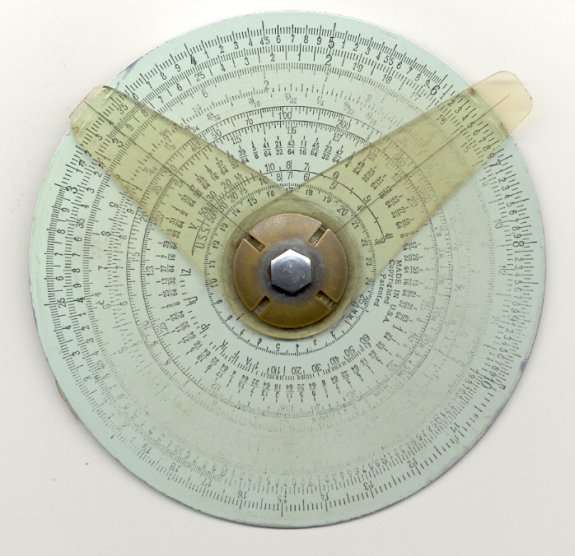
I've figured out how to do a few things with it, including fraction/decimal
conversions and reciprocals, but whether it's got the ability to
do general multiplication/division or even square roots is obscure.
(The other side is a straightforward circular trig table.) I discern
no equivalent of an A nor a D scale, nor how the two hairlines interact.
I think it's this
item, but lacking a manual I have no way to be sure, and there's
no manufacturer's name on it.
So let it not be said that slide rules are extinct. I'm guessing
that somewhere is a manufacturer still producing cardboard species
as promo items, as I got a world time calculator at a trade show
booth as recently as 1996. I like them, as each one doesn't need
its own damned wall wart, and they can show relationships as well
as values. Toss 'em in a drawer, and when you need one, well, it
still works. "Analog" is a real word!

|
 April
3, 2008: The Other Kind of Fifties Moment April
3, 2008: The Other Kind of Fifties Moment
 The
massive urban renewal project that is the inside of my mouth got
into high gear again this morning, with what I call a three-p procedure:
It took six hours, with three pee breaks, and (I am not exaggerating
!) fifteen separate injections of local anaesthetic. Uggh.
The surgeon removed my lower horseshoe, which has been in my mouth
since September 2001, and cleaned up what damage had occurred during
seven years in place. Two fillings had to be drilled out and replaced,
and all the teeth had to be re-margined. One tooth, while not infected,
had broken into three pieces underneath the horeshoe (probably due
to my perpetual clenching and grinding during the night) and no
longer has enough structure above the gum line to be retained. It
will have to be pulled, and later this year (once the bone heals)
an implant post will be put in place to carry the eventual crown. The
massive urban renewal project that is the inside of my mouth got
into high gear again this morning, with what I call a three-p procedure:
It took six hours, with three pee breaks, and (I am not exaggerating
!) fifteen separate injections of local anaesthetic. Uggh.
The surgeon removed my lower horseshoe, which has been in my mouth
since September 2001, and cleaned up what damage had occurred during
seven years in place. Two fillings had to be drilled out and replaced,
and all the teeth had to be re-margined. One tooth, while not infected,
had broken into three pieces underneath the horeshoe (probably due
to my perpetual clenching and grinding during the night) and no
longer has enough structure above the gum line to be retained. It
will have to be pulled, and later this year (once the bone heals)
an implant post will be put in place to carry the eventual crown.
So here I am at home, groggy on painkillers, watching out my window
as a blizzard rages on the slopes of my mountain. What month is
this again? We already have four inches out there and it's still
coming down hard. A friend at church told us that this has been
the wettest, coldest, longest winter he's seen the whole
sixteen years he's lived here.
And tomorrow morning at 7, I go back for six more hours to accomplish
a similar treatment on the uppers. Alas, the upper horeshoe is in
pretty tight (a good thing, actually, for my teeth's sake these
past seven years) and the surgeon will have to cut it out in chunks
using diamond burrs. (I'll be tasting stainless steel for weeks.)
But to the story at hand: I asked the young dental surgical assistant
if I could have the lower horseshoe back so I could put it on my
curio shelf. She said sure, and asked what else I had on the shelf.
I ran down the short-form list:
- A horse vertebra.
- A cow skull that wears my Lane Tech high school mortarboard.
- A radio-controlled rat.
- A Pope Benedict XVI bobble-head.
- A stuffed squirrel that giggles when you press his tummy.
- A meteorite fragment given me by Pete Albrecht.
- A Giant Squid action figure.
- A Tim-Bird ornithopter
- My father's slide rule.
She smiled, nodded, and then asked, "What's a slide rule?"
I explained as best I could. I realized that this was the other
kind of Fifties Moment; that is, when you realize that you're in
your fifties and almost everybody else isn't. I ache for the day—though
I will probably not live to see it—when graying Gen-Y fiftysomethings
talk about their vintage gear collection, and some young punk asks,
in all sincerity: "What's an iPod?"

|
|

